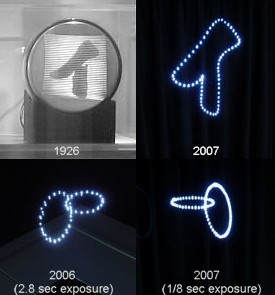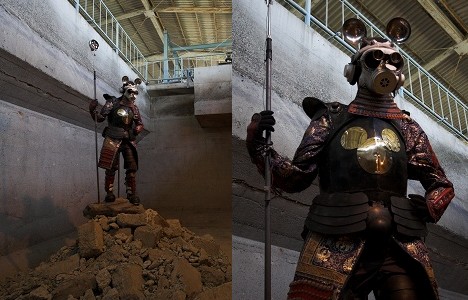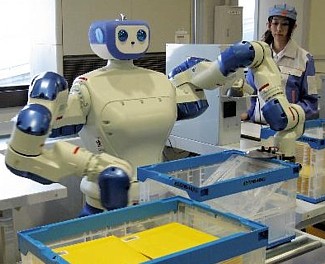 In 1926, Kenjiro Takayanagi, known as the "father of Japanese television," transmitted the image of a katakana character (?) to a TV receiver built with a cathode ray tube, signaling the birth of the world's first all-electronic television. Last week, in a symbolic gesture over 80 years later, researchers from Japan's National Institute of Advanced Industrial Science and Technology (AIST), Burton Inc. and Hamamatsu Photonics K.K. displayed the same katakana character using a 3D projector that generates moving images in mid-air.
In 1926, Kenjiro Takayanagi, known as the "father of Japanese television," transmitted the image of a katakana character (?) to a TV receiver built with a cathode ray tube, signaling the birth of the world's first all-electronic television. Last week, in a symbolic gesture over 80 years later, researchers from Japan's National Institute of Advanced Industrial Science and Technology (AIST), Burton Inc. and Hamamatsu Photonics K.K. displayed the same katakana character using a 3D projector that generates moving images in mid-air.
The 3D projector, which was first unveiled in February 2006 but has seen some recent improvements, uses focused laser beams to create flashpoint "pixels" in mid-air. The pixels are generated as the focused lasers heat the oxygen and nitrogen molecules floating in the air, causing them to spark in a phenomenon known as plasma emission. By rapidly moving these flashpoints in a controlled fashion, the projector creates a three-dimensional image that appears to float in empty space.
The projector's recent upgrades include an improved 3D scanning system that boosts laser accuracy, as well as a system of high-intensity solid-state femtosecond lasers recently developed by Hamamatsu Photonics. The new lasers, which unleash 100-billion-watt pulses (0.1-terawatt peak output) of light every 10-trillionths of a second (100 femtoseconds), improve image smoothness and boost the resolution to 1,000 pixels per second. In addition, image brightness and contrast can be controlled by regulating the number of pulses fired at each point in space.
The researchers say these improvements bring us one step closer to realizing the dream of 3DTV, but considering it took eight decades for Takayanagi's primitive 40-scan-line television to evolve into our present-day HDTV, we might have a while to wait.
[Source: AIST press release]




 The Mickey Mouse Gas Mask was manufactured in 1942, at a time when segments of the American population, particularly those in Hawaii, feared a potential gas attack by the Japanese. With the permission of Walt Disney himself, 1,000 of the masks were produced for the US Army, who distributed them to civilians in the hope that the friendly, toy-like design would encourage children to carry them around and wear them for longer periods of time should an actual attack ever occur, thus improving their chances for survival. Apparently, this concept inspired Yanobe to create Mickey the Knight.
The Mickey Mouse Gas Mask was manufactured in 1942, at a time when segments of the American population, particularly those in Hawaii, feared a potential gas attack by the Japanese. With the permission of Walt Disney himself, 1,000 of the masks were produced for the US Army, who distributed them to civilians in the hope that the friendly, toy-like design would encourage children to carry them around and wear them for longer periods of time should an actual attack ever occur, thus improving their chances for survival. Apparently, this concept inspired Yanobe to create Mickey the Knight.
 Over the past several months, small stacks of envelopes, each containing a 10,000 yen bill (about $85) and a handwritten letter, have been turning up in the restrooms at prefectural offices across Japan. On July 11, officials announced the mystery money has been found in 33 different restrooms in government offices located in 15 prefectures -- Hokkaido, Aomori, Miyagi, Akita, Niigata, Saitama, Chiba, Shizuoka, Tokyo, Osaka, Nara, Hyogo, Oita, Nagasaki and Miyazaki.
Over the past several months, small stacks of envelopes, each containing a 10,000 yen bill (about $85) and a handwritten letter, have been turning up in the restrooms at prefectural offices across Japan. On July 11, officials announced the mystery money has been found in 33 different restrooms in government offices located in 15 prefectures -- Hokkaido, Aomori, Miyagi, Akita, Niigata, Saitama, Chiba, Shizuoka, Tokyo, Osaka, Nara, Hyogo, Oita, Nagasaki and Miyazaki.  On the morning of July 10, police responding to an emergency call in the town of Miura, about 30 miles south of Tokyo, found a bound and gagged man lying apparently unconscious next to a forest road. The victim, a 22-year-old Leading Seaman stationed at the Japan Maritime Self-Defense Force base in Yokosuka, told police a man had attacked him, tied his hands, stuffed a towel in his mouth and dumped him alongside the wooded road.
On the morning of July 10, police responding to an emergency call in the town of Miura, about 30 miles south of Tokyo, found a bound and gagged man lying apparently unconscious next to a forest road. The victim, a 22-year-old Leading Seaman stationed at the Japan Maritime Self-Defense Force base in Yokosuka, told police a man had attacked him, tied his hands, stuffed a towel in his mouth and dumped him alongside the wooded road.  Industrial robot maker Yaskawa Electric has teamed up with megaconglomerate Mitsui & Co., Ltd. and packaging system manufacturer Hokusho Co., Ltd. to develop a parcel sorting system that employs agile robot workers capable of quickly classifying and separating small items such as mail packages and clothing. The system, now being demonstrated at one of Hokusho's factories, employs Yaskawa's Motoman-DIA10, which features a pair of smooth-moving, seven-axis robotic arms mounted on a human-sized torso.
Industrial robot maker Yaskawa Electric has teamed up with megaconglomerate Mitsui & Co., Ltd. and packaging system manufacturer Hokusho Co., Ltd. to develop a parcel sorting system that employs agile robot workers capable of quickly classifying and separating small items such as mail packages and clothing. The system, now being demonstrated at one of Hokusho's factories, employs Yaskawa's Motoman-DIA10, which features a pair of smooth-moving, seven-axis robotic arms mounted on a human-sized torso.  Researchers at Japan's Jikei University will soon be checking the mailbox for a cool package from Siberia -- the recently discovered frozen body of an ancient baby mammoth. The nearly complete body of the female calf, said to be one of the best-preserved specimens of frozen mammoth ever discovered, is estimated to have been less than one year old before it was preserved in ice about 10,000 years ago.
Researchers at Japan's Jikei University will soon be checking the mailbox for a cool package from Siberia -- the recently discovered frozen body of an ancient baby mammoth. The nearly complete body of the female calf, said to be one of the best-preserved specimens of frozen mammoth ever discovered, is estimated to have been less than one year old before it was preserved in ice about 10,000 years ago.